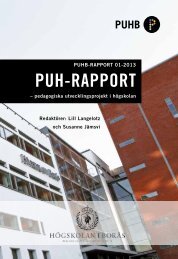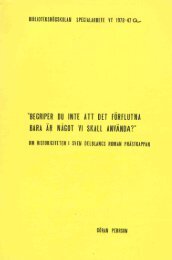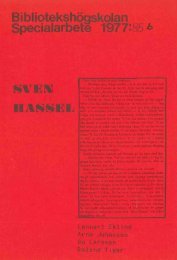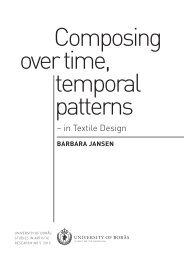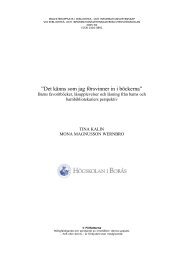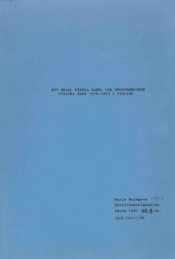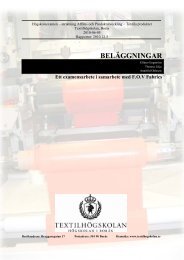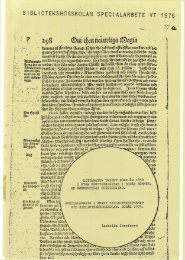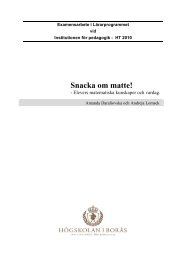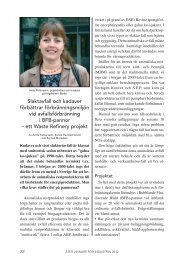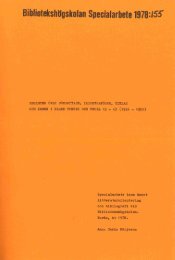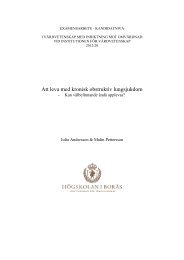KURBITCH! - BADA
KURBITCH! - BADA
KURBITCH! - BADA
Create successful ePaper yourself
Turn your PDF publications into a flip-book with our unique Google optimized e-Paper software.
From ornament to structure step by step<br />
1. Tools needed for experimentation.<br />
2. Kurbits projected onto a square piece of<br />
fabric.<br />
Finding form<br />
One of the questions in this work was to find new ways to use ornamentation and free it from being<br />
regarded as secondary to construction. An approach to this was to make ornaments into construction.<br />
This succeeded in the way that the outcome shows that it is possible to transform the structure of<br />
ornament into construction.<br />
In the process of making the structure of ornaments into form, the projector has been an important<br />
working tool. A picture of a traditional Swedish kurbits has been projected and traced onto a square<br />
piece of fabric. The next step is to cut out the pattern of the ornament and start to experiment with the<br />
given shape on the mannequin or, more preferably, my own body. When experimenting on my own body,<br />
I find possibilities that are impossible to reach when draping on a mannequin.<br />
What is interesting with this way of building shape is the contrast between the dynamic lines of ornament<br />
and the static square, between the body close and the void. The ornament’s organic lines interact and<br />
embrace the body and discover new paths around it. On the other hand, the square provides with areas<br />
that form into space between body and dress. I started by using a stiff but lightweight non-woven fabric<br />
that enhances the space and is an influential variable in creating this sculptural silhouette.<br />
3. Exploring different possibilities<br />
for the cut out kurbits on myself.<br />
4. First design proposal fitted on mannequin.<br />
When working with this method, intuition has been of great use when choosing which ornament to use<br />
as model for experiment. I can predict most likely if a certain ornament will work in a structural way<br />
or not, even if I cannot say what garment it will form. This is determined in the next step of the process<br />
when I start to experiment on my own body. A garment is held up either by resting on the shoulders or<br />
the hips. Therefore, the decision to put my head through a hole formed by the cut out ornament leads to<br />
the fact that it most likely will turn out as an upper garment such as a top, jacket, coat or dress, unlike<br />
the choice to make the hole a bit bigger and place it at the waist, which then will form a skirt or a pair<br />
of trousers.<br />
5. Modification of pattern. 6. Second design proposal fitted on mannequin.<br />
Another factor in the determination of garment, according to this method, is how big a square the<br />
ornament is placed upon. A smaller square will lead to a jacket or a short dress, in contrast to a bigger<br />
square which will lead to a full-length dress or a coat. In the beginning of my process, this was made<br />
completely by chance, as the choice of ornament. But the further I went in my experimentation, I<br />
learned to understand the relationship between size and shape of the ornament in contrast to the size<br />
of the square. This understanding allowed me to control my process, if not completely, then at least a bit<br />
towards a planned outcome.<br />
7. Different material tested and evaluated, here<br />
denim strengthened with wooden glue solution.<br />
8. Later the design changed into the jacket presented<br />
in outfit 3. Final prototype.<br />
22 23



